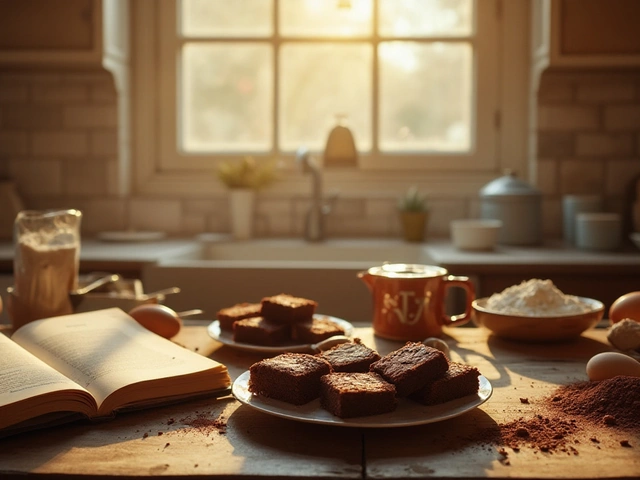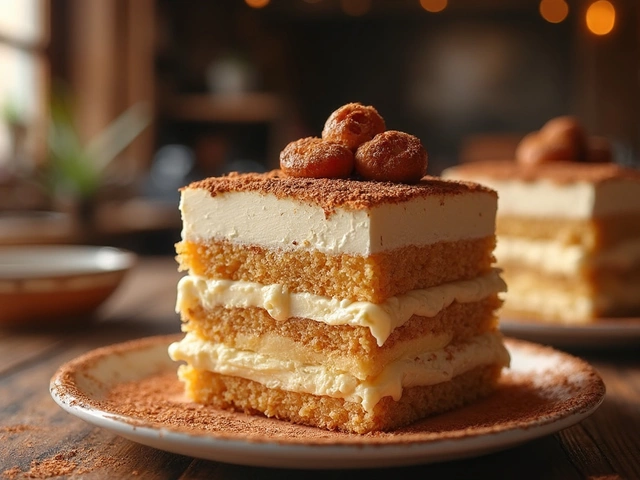
Let’s face it—nobody wants to see those delicate, colorful macarons turn into a mushy mess or rock-hard disappointment. If you spent time (and probably a small fortune) making or buying real French macarons, the last thing you want is to ruin them trying to make them last. So can you freeze macarons? The short answer is yes, but only if you know what you’re doing.
Macarons are all about texture. The crispy shell and chewy center are what make them stand out from any other sweet, and the freezer can quickly mess that up if you rush the process. But if you wrap them right and keep them dry, you can stretch their life way beyond just a few days on the counter. Whether you’re prepping ahead for a party or just want to hide a few for yourself (no shame), understanding the basics can make all the difference.
Stick around and you’ll find out exactly how to freeze, store, and thaw macarons without losing that perfect bite. Forget soggy, sticky shells or fillings that drip—there’s a way to keep your macarons tasting almost as good as fresh. Ready to get into the nitty-gritty?
- Why People Want to Freeze Macarons
- What Happens If You Freeze Macarons
- How To Freeze Macarons the Right Way
- Thawing Macarons Without Ruining Them
- Biggest Freezing Mistakes With Macarons
- Shelf Life and Extra Storage Tips
Why People Want to Freeze Macarons
There are lots of reasons folks try to freeze macarons instead of just keeping them on the counter. Let’s be honest, good macarons aren’t cheap, and baking them at home takes time and effort. Freezing just makes sense if you want to get more out of your batch and avoid waste.
For most people, it comes down to planning ahead. Maybe you’ve got a birthday coming up and want to prep dessert early, or you made a giant batch and can’t eat them all in one go (as tempting as that sounds). Bakeries do this, too. Even big-name Parisian shops freeze part of their stock so they can handle big orders and keep those colorful treats looking sharp on busy weekends.
Then there’s the issue of shelf life. At room temperature, macarons will only last two to three days before the shells start going soft and the filling takes over. Even in the fridge, you only get about a week before the texture changes. But pop them in the freezer, and you’re looking at up to three months for most flavors without losing too much crunch or chewiness. That’s a huge win if you want to dodge last-minute stress for parties or gifts.
- Homemade bakers can save time by prepping in bulk and freezing for later.
- Bakeries can handle bigger orders and reduce daily waste.
- People with special diets (like gluten-free) can make safe treats in advance.
- Seasonal flavors can stick around longer than just a week in the fridge.
Check this out: a lot of pros say that freezing macarons can even help with the texture if you store them right, because the rest period in the freezer helps the flavors blend and the shells fully hydrate. The caveat? You have to handle them with care so you don’t end up with soggy or crumbly disappointment when you thaw.
What Happens If You Freeze Macarons
So, what’s the real deal when you stick macarons in the freezer? Simply put, it’s all about the texture. Freeze them wrong, and you’ll get shells that crack, fillings that seep out, or even a chewy center that turns stiff. But do it right, and most people honestly can’t tell the difference between fresh and frozen. That’s why bakeries all over Paris use freezing to manage their inventory without getting caught with stale treats.
When you freeze macarons, the shells can absorb moisture if you don’t seal them tight. This usually leads to sogginess or squishy bites. On the flip side, the ganache or buttercream fillings can get hard—nobody wants to chip a tooth on a dessert. If you rush thawing, you might also end up with condensation, which makes everything sticky and ruins the crisp outer layer that makes macarons special.
Here’s what typically happens if you freeze macarons:
- Shells: Can stay intact and crispy if well packed but sometimes crack or turn too soft if exposed to air or condensation.
- Fillings: Usually freeze well, but high-moisture fillings (like jams or fruit purees) might leak or separate when thawed.
- Color: Colors tend to hold up unless the shells get wet—then you may see splotchy or faded patches.
- Taste: The flavor is usually fine, but stale or freezer-burned macarons can taste bland or funky.
If you’re curious about shelf life differences, check out this quick breakdown:
| Storage Method | Typical Shelf Life |
|---|---|
| Room Temperature (Airtight) | 2-3 Days |
| Refrigerator | Up to 5 Days |
| Freezer | Up to 3 Months |
One more thing: if you’re dealing with macarons from a fancy pâtisserie, ask them about freezing. Some macarons might have unusual fillings that don’t play nice with the cold. So yeah—freezing macarons works, but go in with a plan if you want to keep those pretty treats from turning into sad, soggy blobs.
How To Freeze Macarons the Right Way
Freezing macarons can totally work if you do it right, but they hate moisture and rough handling. The goal here: avoid soggy shells and keep those beautiful chewy centers. No shortcuts—each step matters.
Here’s the best way to freeze macarons, with tips used by top bakers (and even macaron shops):
- Let them mature first. If you just baked them, stash them in the fridge for at least 24 hours. This lets the flavor and filling settle—straight-from-the-oven shells never freeze or thaw well.
- Separate layers gently. Line a container or baking tray with parchment paper. Place macarons in a single layer. If you need to stack, add parchment or wax paper between layers to block sticking and any flavor or color transfer.
- Tightly wrap them. Wrap the container tightly with plastic wrap (or use an airtight lid). Air is the enemy—exposure can dry out your macarons or make them freezer-burned.
- Double-wrap for extra protection. If you want to be extra safe, put the container in a zip-top freezer bag. Squeeze out as much air as possible.
- Label and date it. Macarons can get lost in the freezer shuffle. Mark the date and flavors—most store well for about a month in the freezer, but up to two is possible for less creamy fillings.
Big tip: Not all macaron fillings freeze the same. Ganache and buttercream do great, but creamy fillings like cream cheese or ones heavy in fruit can separate or go grainy. Plain shells (no filling) can be frozen for even longer— often up to 3 months—without much change at all.
Here’s a quick breakdown of best freezer times, if you’re the planning type:
| What | Freezer Life |
|---|---|
| Filled macarons (buttercream/ganache) | 1-2 months |
| Plain shells | Up to 3 months |
| Fruit/cream cheese-filled | Up to 4 weeks (quality drops off fast after) |
Following these steps helps protect the texture and flavor of your frozen macarons, so when you finally give in and grab one from the freezer, it’ll actually taste and look as good as you remember.

Thawing Macarons Without Ruining Them
If you want your macarons to taste and feel just right after freezing, the thawing part is a big deal. Skip this, and you’ll wind up with shells that crack, turn wet, or lose that satisfying bite everyone obsesses over.
First thing: never thaw freeze macarons out in the open or with their container lid off. Condensation will hit them fast, turning those crisp tops into sticky disasters. Here’s exactly how to bring them back to life without making a mess:
- Take your frozen macarons straight from the freezer and leave them in their airtight container.
- Move the whole container to your fridge. Let it hang out there for at least a couple of hours (overnight works safest if you've got the patience).
- After 2–4 hours, check to make sure they’ve thawed. Now—finally—open the container and let them sit at room temp for 10–15 minutes before eating. This helps the centers soften just enough, so they’re not fridge-cold.
Don’t try to rush things with a microwave or warm spot. Temperatures rising too quickly invite cracks, chewy shells, or even weird, rubbery fillings.
Some pros say this fridge-thawing trick is the best way to avoid moisture overload. To keep things clear, take a look at this quick comparison of thawing methods:
| Method | Result |
|---|---|
| In container, fridge then room temp | Best texture, no soggy shells |
| On counter, open container | Sticky tops, can go mushy |
| Microwave or heat | Weird texture, sometimes splitting shells |
Once they hit room temp, enjoy them within a few hours. Seriously, don’t store macarons at room temperature once thawed for more than a day. That’s when the shells get stale or chewy (not in a good way).
So, next time you’re saving your macaron stash for later, remember: slow and steady thawing is your friend. This simple routine keeps your macarons as close as possible to bakery-fresh.
Biggest Freezing Mistakes With Macarons
If you’re hoping to freeze macarons and have them taste fresh again later, it’s surprisingly easy to mess things up. Even small mistakes can leave you with cracked shells, weird textures, or just something that doesn’t taste right. Here’s what trips up even the pros:
- Freezing When They're Still Warm: Tossing in macarons that haven’t cooled all the way pretty much guarantees condensation inside the shells, making them sticky or soggy once thawed.
- Not Using Airtight Containers: Macarons soak up flavors and moisture like little sponges. If you just pop them in a zip bag or flimsy container, they can pick up freezer burn, off-odors, or turn chewy in a bad way.
- Storing With Strong-Smelling Foods: Buttercream and almond shells pick up whatever is around. Fish, garlic, onions nearby? Your delicate macarons will taste like someone’s dinner.
- Not Separating Layers: If you just throw your macarons in a container all together, they stick, break, and lose that clean look. Always separate layers with parchment or wax paper so you don’t end up with a colorful pile of crumbs.
- Freezing for Too Long: Most macaron pros agree that three months in the freezer is max. Longer than that, and the shells start breaking down or the fillings might separate. Mark the date!
Here’s a quick table to keep track of the shelf life for storing macarons:
| Storage Method | How Long They Last |
|---|---|
| Room Temp (Airtight) | 1-2 days |
| Fridge | Up to 1 week |
| Freezer (Properly Packed) | 2-3 months |
The last thing: never thaw macarons in the microwave or somewhere warm. Rushing this step just leads to mushy, tasteless shells. Always let them sit in the fridge first, then bring to room temp for best results. Do these simple things and your macaron care will actually pay off with every bite.
Shelf Life and Extra Storage Tips
If you’re hoping to stretch the life of your macarons, a little know-how can keep them tasting legit. At room temp, macarons are usually good for 1 to 2 days if the room isn’t too warm or humid. After that, the shells start to soften and lose their snap. In the fridge, the shelf life jumps up to about a week, assuming you put them in an airtight container – this is non-negotiable for anyone serious about storing macarons the right way.
Here’s the cool part: stash them in the freezer and you can make them last for up to 1 month without a major loss in quality. Some bakeries freeze their own stock for up to 3 months, but at home, 1 month is usually the sweet spot before subtle changes in texture show up.
| Storage Location | Shelf Life | Best Container |
|---|---|---|
| Countertop | 1-2 days | Airtight box, cool area |
| Fridge | Up to 1 week | Airtight container, don’t stack directly |
| Freezer | 1 month (homemade), 2-3 months (commercial) | Airtight container, layers with parchment |
Nothing ruins the fun faster than a freezer-burned or sweat-soaked batch, so here are some tips:
- To avoid freezer burn, double-wrap in plastic and then put the wrapped macarons in a good quality freezer-safe box. No gaps means less risk of ice crystals wrecking the shells.
- Keep strong-smelling foods far away or use a dedicated container, since macarons suck up fridge or freezer odors like a sponge.
- If you need just a few macarons at a time, freeze in small portions or single layers, so you don’t have to thaw and refreeze the whole batch—refreezing is almost a guaranteed way to get weird textures.
- Label your containers with the date you froze them. It sounds nerdy, but it’s the easiest way to track down old batches.
One more thing—always bring frozen or refrigerated macarons to room temperature before eating. About 30 minutes on the counter brings back the right texture and flavor. The shell should be crisp but not dry, and the filling should be smooth, not runny or stiff. If they taste off or look weird (like lots of cracks or wet spots), better safe than sorry—skip them.








Write a comment